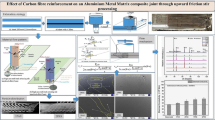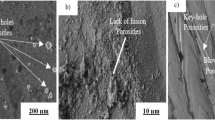Abstract
In this work, brazing of porous copper foam (PCF) to copper (Cu) using amorphous Cu-9.7Sn-5.7Ni-7.0P (in weight, wt%) filler metal has been performed. PCF with different pore densities of 15 pore per inch (PPI), 25 PPI, and 50 PPI were sandwiched in between amorphous Cu-9.7Sn-5.7Ni-7.0P filler/Cu based plate. A brazed joint of Cu/Cu using amorphous Cu-9.7Sn-5.7Ni-7.0P filler was prepared for comparison purposes. The interfacial microstructures and mechanical properties of the brazed joint were investigated to study the joint ability after the brazing process. Scanning electron microscope (SEM) confirmed the interfacial microstructure by the formation of the diffusion layer (shown in light shaded area) and filler layer (gray island-shaped) for both Cu/Cu and Cu/PCF/Cu brazed joint. The X-ray diffraction (XRD) patterns identified the brittle phases of Cu3P and Ni3P, Cu and Cu6Sn5 phases at the diffusion layer. In the shear test, the strength value decreases with increase in the pore densities of PCF. The decreasing shear strength observed with an increase in the number of PPI in PCF is due to the formation of more cavities in Cu/PCF as the number of PPI in Cu/PCF increases.











Similar content being viewed by others
References
Tatt TK, Muhamad N, Muchtar A, Sulong AB, Cherng NM (2016) Influence of sintering parameters on the compressive yield strength of stainless steel foams produced by the space holder method. Sains Malaysiana 45:653–658
Xia X, Chen X, Sun C, Li Z, Liu B (2017) International Journal of Heat and Mass Transfer Experiment on the convective heat transfer from airflow to skeleton in open-cell porous foams. Int J Heat Mass Transf 106:83–90
Mancin S, Zilio C, Diani A, Rossetto L (2012) Experimental air heat transfer and pressure drop through copper foams. Exp Thermal Fluid Sci 36:224–232
Nawaz K, Bock J, Jacobi AM (2017) Thermal-hydraulic performance of metal foam heat exchangers under dry operating conditions. Appl Therm Eng 119:222–232
Boomsma K, Poulikakos D, Zwick F (2003) Metal foams as compact high performance heat exchangers. Mech Mater 35:1161–1176
Luvata (2006) Brazing handbook (5th ed.). American Welding Society, United States of America
Liu W, Li S, Li X, Gao X (1990) Crystallization of amorphous Cu-6Ni-10Sn-7P alloy ribbons. J Mater Sci 9:904–905
Zhang J, Yu W, Lu W (2016) Mechanical properties and microstructure of pure copper joints brazed with amorphous Cu68.5Ni15.7Sn9.3P6.5 filler metal. IJSSST 17:15–19
Weiyuan Y, Wenjiang L, Tiandong X (2013) Formation process of joints brazing with amorphous filler metal. Rare Metal Mater Eng 42:688–691
Zhang PL, Yao S, Ding M, Lu FG, Lou SN (2010) Microstructural analysis in the vacuum brazing of copper to copper using a phosphor–copper brazing filler metal. Int J Mater Res 101:1436–1440
Jacobson DM, Humpston G (2005) Diffusion brazing. In: Principles of brazing. ASM International, Ohio, pp 207–216
Zhong Z, Zhou J, Shen X, Ling X (2012) Study on vacuum brazing of glass to Kovar ® alloy with Cu-Ni-Sn-P. Weld J 91:237–240
Li YN, Wang CW, Peng ZL, Yan JC, Liu XS (2011) Dissolution behavior of Cu in Cu-Ag and Cu-P brazing alloys using weld brazing. Trans Nonferrous Met Soc 21:394–399
Şerban VA, Codrean C, Uţu D, Opriş C (2009) Amorphous alloys for brazing copper based alloys. J Phys Conf Ser 144:012098
Xihui D, Xiaoqiang L (2016) Study on vacuum brazed MGH956 alloy with Cu-P-Sn-Ni filler research of brazing MGH956 alloy with Cu-Ni-Sn-Ni filler metal in vacuum. Mater Sci Technol 24:14–19
Hasap A, Noraphaiphipaksa N, Kanchanomai C (2015) Torsional strength and failure of copper alloy brazing joint. Enf Fail Anal 48:174–184
Kalin BA, Suchkov AN, Fedotov VT, Sevryukov ON, Ivannikov AA, Gervash AA (2016) Brazing of Be with CuCrZr-bronze using copper-based filler metal STEMET. Nucl Mater Energy 9:388–393
Lutfi M, Yusof F, Ariga T, Singh R, Abd Shukor MH (2016) Interfacial reaction analysis of Cu-Sn-Ni-P/Cu joint using microwave hybrid heating. Key Eng Mater 701:148–153
Lutfi M, Yusof F, Ramesh S, Ariga T, Hamdi M (2017) A novel method of brazing Cu/Cu-7.0Ni-9.3Sn-6.3P/Cu using microwave hybrid heating. Mater Werkst 48:299–305
Cullity BD (1956) Elements of X-ray diffraction. Addison-Wesly Publishing Company Inc., Massachusetts
Zou J, Jiang Z, Zhao Q, Chen Z (2009) Brazing of Si3N4 with amorphous Ti40Zr25Ni15Cu20 filler. Mater Sci Eng A 507:155–160
Schwartz MM (2003) Brazing, 2nd edn. ASM International, United States of America
Muhamed MN, Omar MZ, Abdullah S, Sajuri Z, Zamri WFHW, Abdullah MF (2018) Brazed joint interface bonding strength of AR500 steel and AA7075 aluminium alloy. Metals 8:668–680
Jamadon NH, Tan AW, Yusof F, Ariga T, Miyashita Y, Hamdi M (2016) Utilization of a porous Cu interlayer for the enhancement of Pb-free Sn-3.0Ag-0.5Cu solder joint. Metals 6:1–15
Hasap A, Noraphaiphipaksa N, Kanchanomai C (2014) The microstructure and strength of copper alloy brazing joints. Weld J 93:116–123
Aminazad AM, Hadian AM, Ghasimakbari F (2015) Investigation on corrosion behaviour of copper brazed joints. Procedia Mater Sci 11:672–678
Miettinen J (2003) Thermodynamic description of the Cu-Ni-Sn system at the Cu-Ni side. Calphad 27:309–318
Funding
This work received financial support from the Fundamental Research Grant Scheme, FRGS University of Malaya under (Project number FP062-2015A), Research Universities, RU University of Malaya under (Project number ST006-2018), and equipments service contribution in Nagaoka University of Technology (Niigata, Japan).
Author information
Authors and Affiliations
Corresponding author
Ethics declarations
Conflict of interest
The authors declare that they have no conflict of interest.
Additional information
Publisher’s note
Springer Nature remains neutral with regard to jurisdictional claims in published maps and institutional affiliations.
Recommended for publication by Commission XVII - Brazing, Soldering and Diffusion Bonding
Rights and permissions
About this article
Cite this article
Zahri, N.A.M., Yusof, F., Miyashita, Y. et al. Brazing of porous copper foam/copper with amorphous Cu-9.7Sn-5.7Ni-7.0P (wt%) filler metal: interfacial microstructure and diffusion behavior. Weld World 64, 209–217 (2020). https://doi.org/10.1007/s40194-019-00804-2
Received:
Accepted:
Published:
Issue Date:
DOI: https://doi.org/10.1007/s40194-019-00804-2




